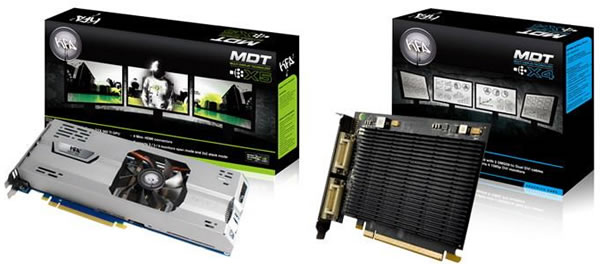The crew over at KFA2 (a part of Galaxy) has unveiled a set of Nvidia graphics cards that feature improved support for multi-display configurations: a GeForce GTX 560 Ti that drives up to five screens and a GeForce 210 that handles four. Marketed as the "KFA2 GTX 560 Ti MDT X5" and "KFA2 210 MDT X4", the cards are equipped with the ViewXpand VMM1400/1402 chipset, which lets you "stack, clone and even create a virtual single display across multiple screens" – an appealing trait for gamers and workaholics alike.
Besides the extended display support, both cards closely follow Nvidia's reference specs. KFA2's GTX 560 Ti features 384 CUDA Cores, GPU/shader clocks of 822/1645MHz, a 256-bit memory interface, 1GB of GDDR5 VRAM clocked at 4008MHz. There are six display outputs are spread across one DVI, one DisplayPort and four mini-HDMIs. Meanwhile, the GeForce 210 MDT X4 has 16 CUDA Cores, GPU/shader clocks of 589/1402MHz, a 64-bit memory interface, 1GB of DDR2 VRAM running at 800MHz, and two DVI ports.

Most of Nvidia's modern GeForce products only support two monitors per card. The almighty dual-GPU GeForce GTX 590 bucked that trend, but still only supports three displays. If someone wants to game on three or more displays, surely they'd be running a multi-GPU solution anyway, so what's the point you ask? In my case, I have two desktop displays running off my GTX 460's two DVI connectors with a TV wired to the mini-HDMI port.
Because the card only supports two screens, I have to use the Nvidia Control Panel to manually disable one of the desktop monitors and enable the TV along with changing the default audio device. Naturally, that has to be reversed when I want to sit back at the desktop. Losing access to the secondary monitor is no big deal if I'm away, but the process is far more cumbersome than it needs to be (and I've since automated it with AHK).